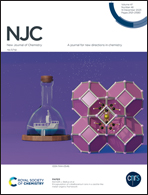Ag and N-doped carbon dot-enhanced H2O2–Co2+ chemiluminescence and its application for the determination of Co2+ and hydroquinone†
Abstract
In this study, Ag and N-doped carbon dots (Ag–NCDs) were used to enhance the ultraweak H2O2–Co2+ (a Fenton-like reaction) chemiluminescence (CL) reaction, in which Ag–NCDs were found to have the functions of catalyst, chelator, and luminophore. Under the co-catalysis of Co2+ and Ag–NCDs, H2O2 dissociation was facilitated, resulting in increased generation of active ˙OH and ˙O2− radicals. Thus, the CL intensity of the Ag–NCDs–H2O2–Co2+ system was significantly higher than that of the H2O2–Co2+ system and the Ag–NCDs–H2O2 system. Co2+ catalyzes the reaction through complex formation with Ag–NCDs’ surface amino groups, thereby accelerating H2O2 decomposition. The CL intensity of the H2O2–Co2+ system increased with increasing Co2+ concentration in the range from 0.4 μM to 40.0 μM with a detection limit of 0.07 μM. Furthermore, we observed that HQ can effectively quench the Ag–NCDs–H2O2–Co2+ CL signal. This led to the application of the CL system for HQ detection, achieving quantitative measurements within the 0.2–20.0 μM concentration range with a detection limit of 0.04 μM. It also enabled sequential determination of Co2+ and HQ in egg yolk, vitamin B12, and water samples, offering simplicity, time-saving, and higher selectivity.



 Please wait while we load your content...
Please wait while we load your content...